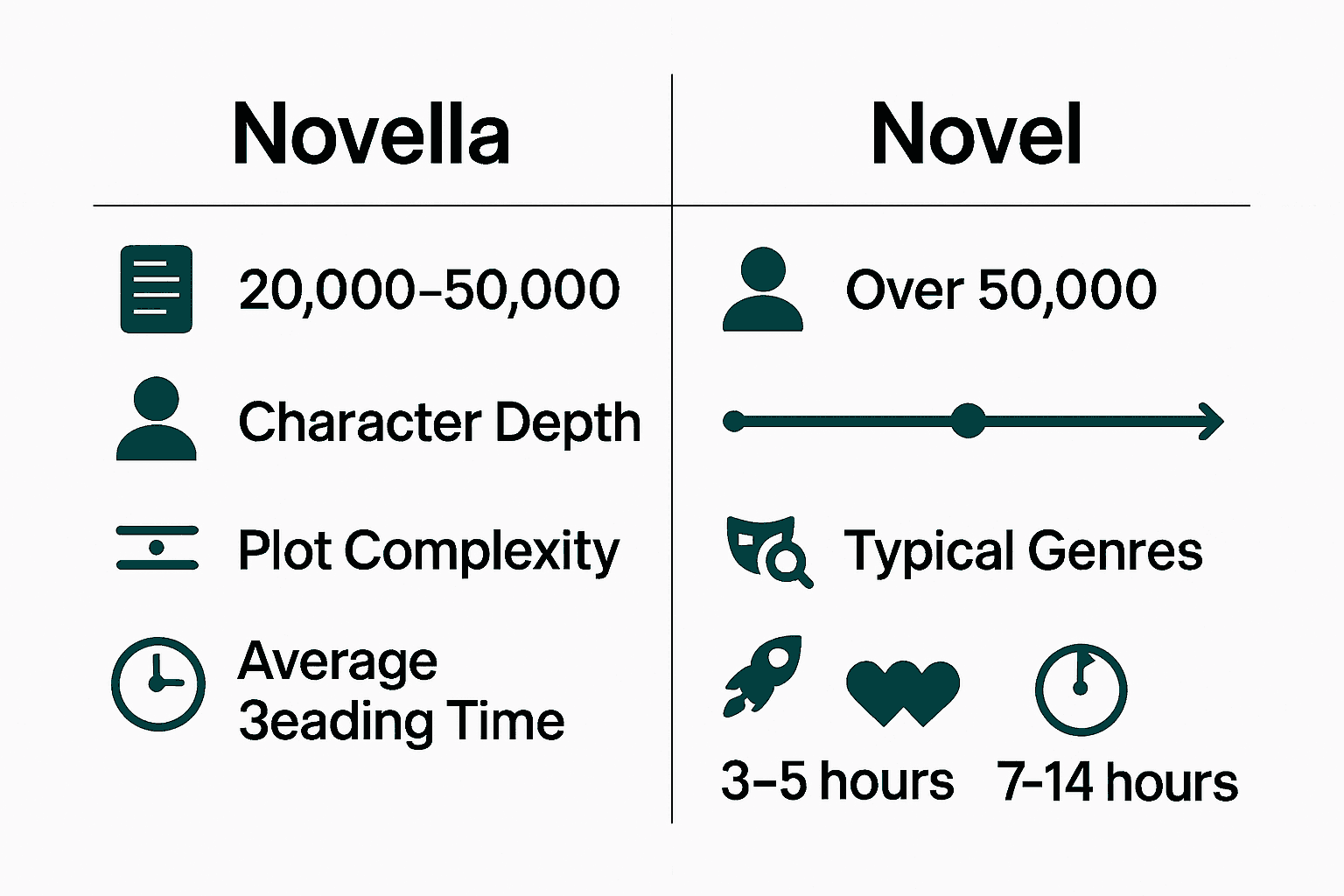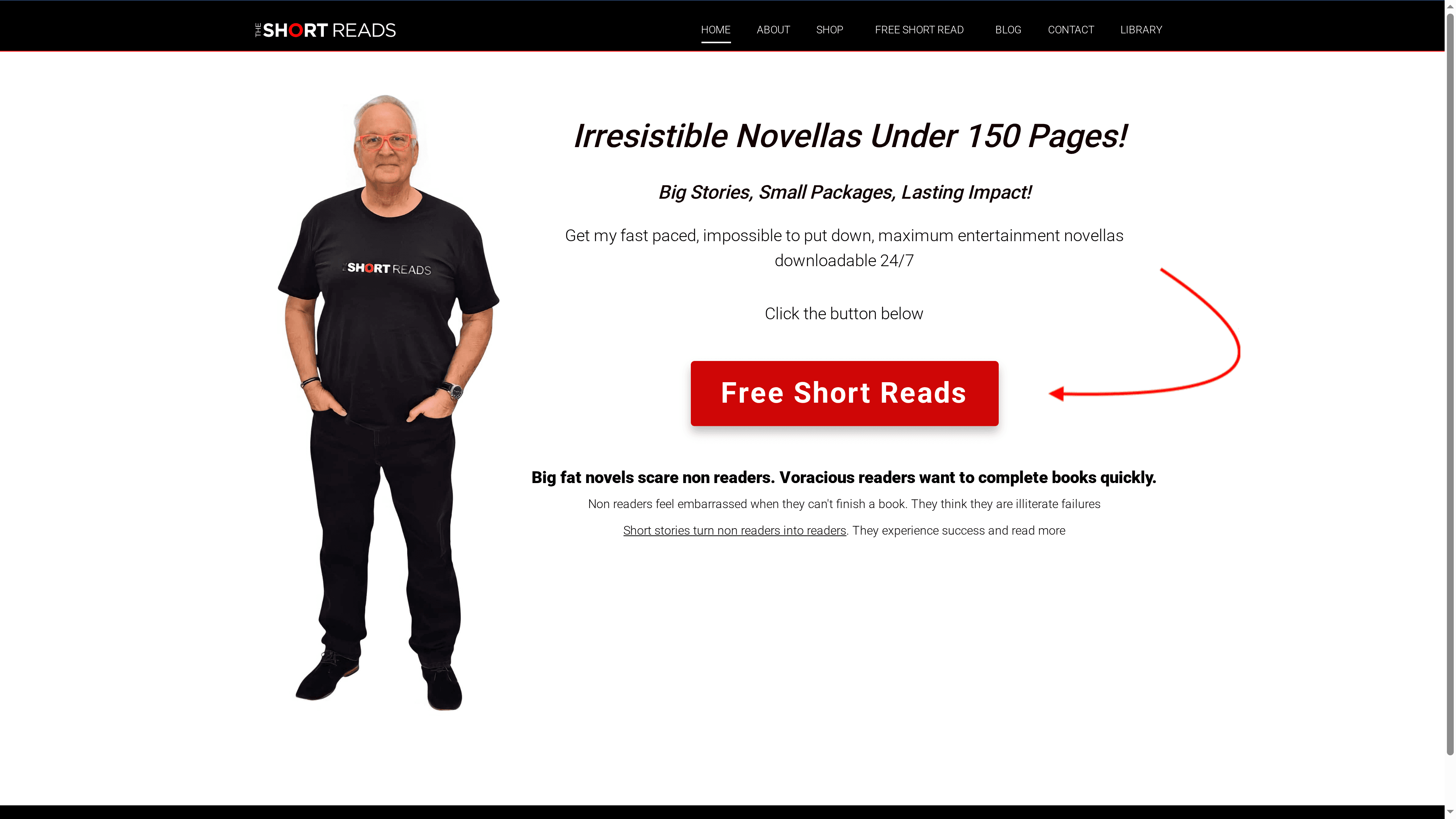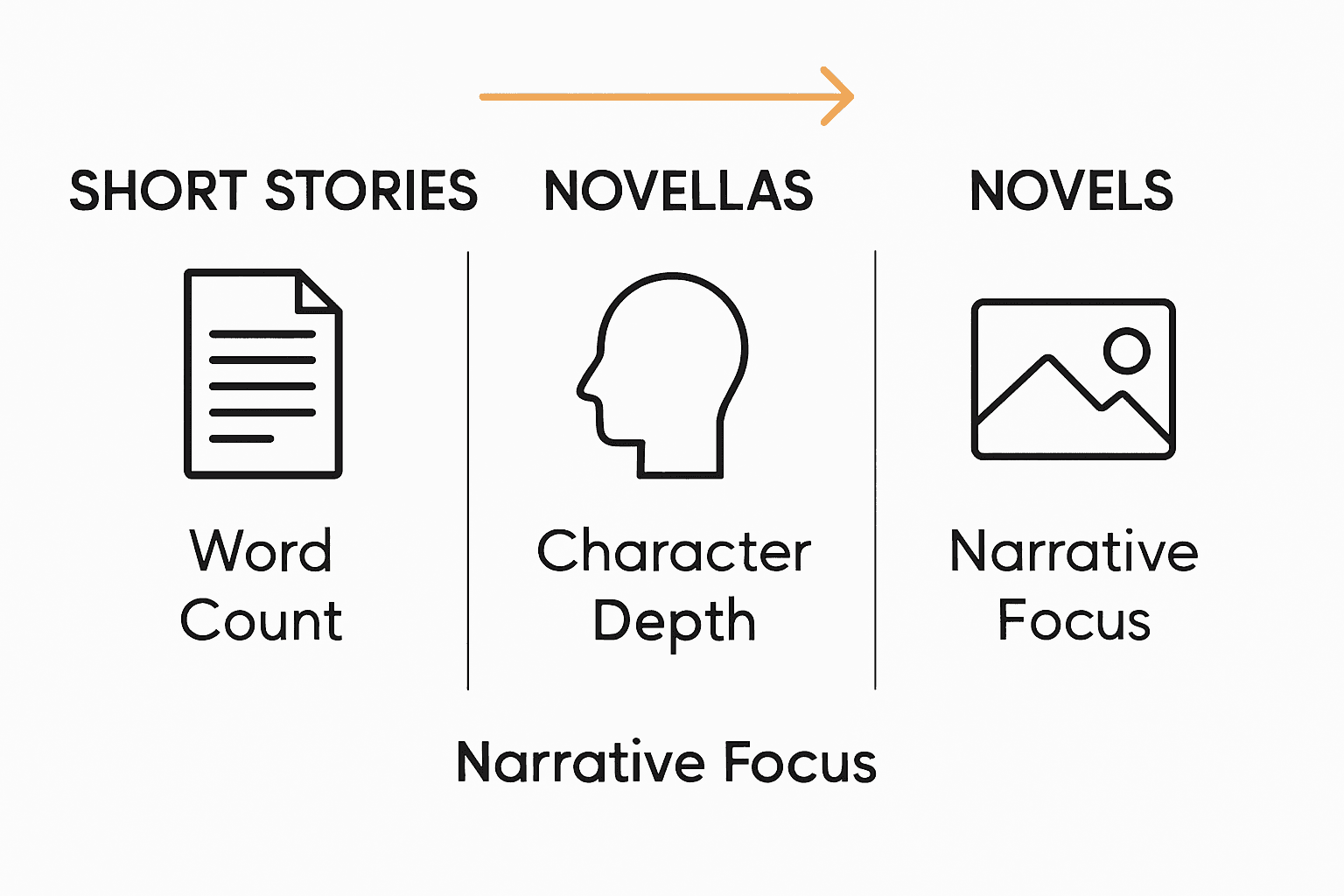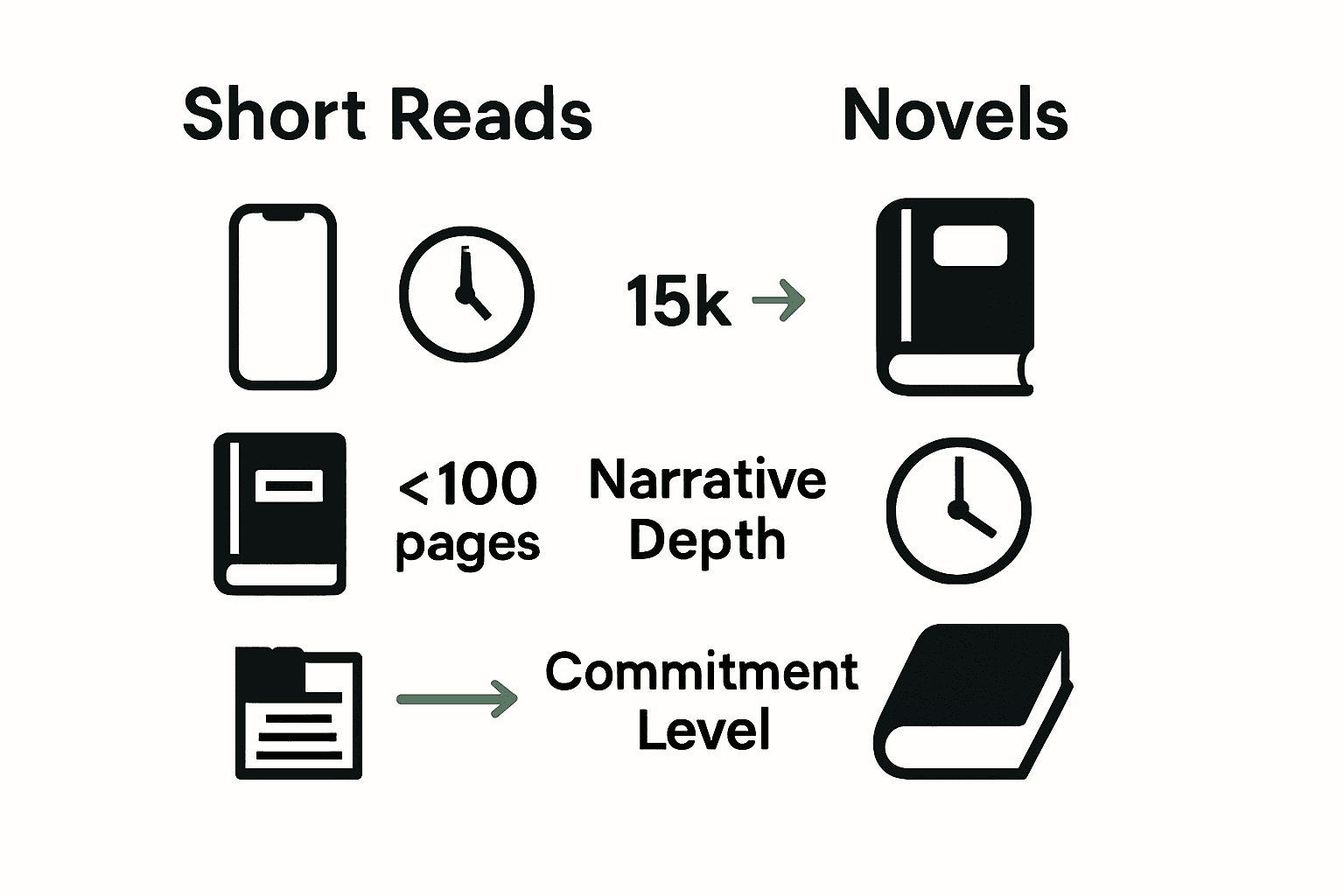Tag Archives for " novels "
Novellas vs. Novels: Complete Guide to Key Differences

A novella offers a unique middle ground in fiction, packing a punch with its concise storytelling. For many readers and writers, knowing whether a story is best told as a novella or a novel can shape the entire reading experience. With novels typically exceeding 50,000 words and novellas ranging from 20,000 to 40,000 words, these two forms provide distinct ways to explore characters and worlds. Understanding their differences helps you choose the right path for your next literary adventure.
Table of Contents
- Defining Novellas And Novels: Core Differences
- Length, Structure, And Narrative Scope
- Genre Trends In Novellas And Novels
- Audience Appeal And Reader Experiences
- Choosing Between Novellas And Novels
Key Takeaways
| Point | Details |
|---|---|
| Length and Complexity | Novellas range from 20,000 to 40,000 words, while novels start at 50,000 words, with the former focusing on a single theme and the latter allowing for intricate plots. |
| Genre Suitability | Novellas excel in concise genres like romance and mystery, whereas novels are suited for expansive explorations like epic fantasy and historical fiction. |
| Reading Experience | Novels deliver immersive storytelling appealing to deep character exploration, while novellas provide quick, impactful narratives ideal for busy readers. |
| Choosing Format | Select a novella for focused narratives and limited complexity, and a novel for multi-dimensional storytelling and extensive world-building. |
Defining Novellas and Novels: Core Differences
Understanding the fundamental differences between novellas and novels is crucial for readers and writers alike. According to research from naac.psou.ac.in, a novella is a prose fiction that sits uniquely between a short story and a novel, characterized by its focused narrative approach and limited scope.
Novella Characteristics
- Typically shorter than a traditional novel
- Concentrates on a single incident or core theme
- Features one or two primary characters
- Often set in a single location
- Can usually be read in one sitting
Novels, in contrast, provide a more expansive storytelling landscape. As detailed by uobabylon.edu.iq, novels are extensive narratives exceeding 40,000 words, enabling authors to craft intricate plots and develop complex character arcs. While novellas maintain a tightly focused narrative, novels allow writers to explore multiple storylines, introduce numerous characters, and delve deeper into thematic explorations.
Novel Characteristics
- Longer narrative format
- Supports complex, multi-layered plots
- Allows extensive character development
- Can include multiple subplots and perspectives
- Generally structured with distinct chapters
The primary distinguishing factor between novellas and novels lies in their narrative complexity and length. Short Reads vs Full Novels: Complete Guide offers additional insights into how these different formats serve unique storytelling purposes. Novellas provide a concentrated, intense reading experience, while novels offer a more immersive and expansive journey through fictional worlds.
Length, Structure, and Narrative Scope
The distinction between novellas and novels becomes most apparent when examining their length, structural complexity, and narrative scope. According to ballard-tighe.com, novels typically start at 50,000 words, offering substantial space for comprehensive storytelling, while novellas range from 20,000 to 40,000 words, providing a more concentrated narrative experience.
Word Count Breakdown
- Novels: 50,000+ words
- Novellas: 20,000 to 40,000 words
- Short Stories: Under 7,500 words
Research from spines.com highlights the fundamental difference in narrative approach. Novellas maintain a narrow focus, concentrating on a single central theme, character, or event, often avoiding the complexity of multiple subplots. Novels, conversely, offer expansive storytelling real estate, enabling writers to weave intricate narratives with multiple characters, rich settings, and interconnected storylines.
Structural Characteristics
- Novels support complex, multi-layered plots
- Novellas maintain a streamlined, focused narrative
- Novels can include extensive character backstories
- Novellas typically explore one primary character arc
For writers and readers seeking more insights into compact storytelling formats, Understanding Short Story Structure: A Deep Dive provides additional context about narrative design across different literary forms. The key takeaway is that while novels offer a panoramic view of a fictional world, novellas provide an intimate, concentrated exploration of a specific narrative moment or character experience.

Genre Trends in Novellas and Novels
Genre selection plays a critical role in determining whether a story is best suited as a novella or a full-length novel. According to aspiringwriteracademy.com, novellas excel in genres that benefit from concise, focused storytelling, such as romance, mystery, and suspense.
Ideal Genres for Novellas
- Romance
- Mystery
- Suspense
- Psychological thrillers
- Tight character studies
Research from inca.ac.id reveals that novellas are particularly effective when concentrating on a singular, central theme or conflict. In contrast, novels provide expansive narrative landscapes that accommodate complex world-building and multiple interconnected storylines, making them perfect for genres requiring deeper exploration.
Ideal Genres for Novels
- Epic fantasy
- Historical fiction
- Science fiction
- Complex family sagas
- Multi-generational narratives
For readers interested in exploring compact storytelling formats, Short Reads vs Novels: Complete Guide for Readers offers additional insights into how different genres leverage various narrative lengths. The key distinction remains that novellas offer intense, concentrated storytelling, while novels provide room for intricate narrative development across multiple plot dimensions.
Audience Appeal and Reader Experiences
The reading experience fundamentally differs between novellas and novels, with each format offering unique engagement for different types of readers. According to differencess.com, novels provide immersive, multi-dimensional storytelling that appeals to readers who enjoy deep character exploration and complex narrative landscapes.
Reader Preferences
- Novels: Readers seeking comprehensive stories
- Novellas: Readers wanting quick, impactful narratives
- Short Stories: Readers desiring ultra-condensed experiences
Research from askbib.com highlights that novellas deliver concise narratives focusing on a single theme or character arc, offering quick yet powerful reading experiences. These compact stories are perfect for busy readers or those seeking concentrated emotional and intellectual engagement without the time commitment of a full novel.

Reading Time Considerations
- Novellas: 1-3 hours reading time
- Novels: 6-12 hours reading time
- Short Stories: Under 1 hour
For readers interested in exploring different storytelling formats, Understanding the Benefits of Short Reads provides additional insights into why compact narratives can be just as compelling as their longer counterparts. The beauty of both formats lies in their ability to transport readers into distinct worlds, whether through a concentrated burst of storytelling or an expansive, immersive journey.
Choosing Between Novellas and Novels
Deciding between writing a novella or a novel requires careful consideration of your story’s core elements and narrative ambitions. According to aspiringwriteracademy.com, critical factors include the complexity of plot, number of characters, and depth of character development.
Key Decision Factors
- Plot complexity
- Character count
- Narrative depth
- Time investment
- Thematic exploration
Research from spines.com suggests that novellas are ideal for focused narratives centered on a single theme or event, while novels provide expansive terrain for exploring multiple storylines and intricate character arcs. Think of a novella as a precise, targeted storytelling approach versus a novel’s panoramic narrative landscape.
Selection Criteria
- Choose novella if:
- Story centers on single character/event
- Limited plot complexity
- Tight narrative focus desired
- Choose novel if:
- Multiple character perspectives
- Complex, interconnected plot
- Extensive world-building needed
For writers seeking additional guidance in selecting the right format, Best Short Books offers insights into crafting compelling narratives across different story lengths. The ultimate decision hinges on your story’s unique requirements and the emotional journey you want to create for your readers.
Discover the Perfect Fit for Your Reading Taste Between Novellas and Novels
If you have ever felt torn between quick, immersive stories and expansive narratives then this guide on “Novellas vs. Novels” clearly highlights the challenge many readers face. The key hurdle is finding a story with the right balance of length and complexity to match your time and mood without sacrificing depth or engagement. Whether you want a focused thriller or a layered plot with multiple characters the right format makes all the difference.
Explore our curated collection of psychological thriller short reads, murder mystery novellas, and detective short reads crafted to deliver precisely that sharp narrative punch or the immersive experience you crave.

Dive into gripping stories that fit your lifestyle right now at The Short Reads. Take control of your reading journey with our handpicked selection and see why countless readers choose quality over quantity today! Don’t wait to experience storytelling that fits your pace and sparks your imagination. Start browsing now and find your next captivating read at online short reads.
Frequently Asked Questions
What is the primary difference between a novella and a novel?
The primary difference lies in length and narrative complexity: novellas are typically 20,000 to 40,000 words and focus on a single incident or theme, while novels exceed 50,000 words and support complex, multi-layered plots with multiple characters and subplots.
How long does it typically take to read a novella compared to a novel?
Novellas usually take 1-3 hours to read, whereas novels can require 6-12 hours, depending on their length and complexity.
What genres are best suited for novellas?
Novellas excel in genres that benefit from concise storytelling, such as romance, mystery, suspense, and psychological thrillers, focusing on a singular theme or character arc.
How do I decide whether to write a novella or a novel?
Consider factors such as plot complexity, character count, narrative depth, and the emotional journey you want to create. If your story centers on a single event or has limited complexity, a novella may be ideal. For more intricate narratives with multiple perspectives, a novel is the better choice.
Recommended
- Short Reads vs Full Novels: Complete Guide – TheShortReads.com
- Short Reads vs Novels: Complete Guide for Readers – TheShortReads.com
- What is Flash Fiction? Understanding This Unique Story Form – TheShortReads.com
- 7 Mystery Fiction Types for Learners and Busy Readers – TheShortReads.com
The Essential Guide to the Role of Novellas in Fiction

More than 60 percent of avid readers seek stories they can finish in just a few sittings, yet crave the depth often missing from short stories. Novellas answer this need by combining rich character development with a focused narrative that never drags. These compact works have carved out a special place in modern fiction, offering readers a satisfying blend of brevity and substance for those moments when time is short but substance still matters.
Table of Contents
- Defining Novellas In Modern Fiction
- Novella Types And Genre Variations
- Core Characteristics And Unique Appeal
- Impact On Readers And Literary Culture
- Comparing Novellas To Short Stories And Novels
Key Takeaways
| Point | Details |
|---|---|
| Definition of Novella | A novella is a narrative form bridging short stories and novels, typically ranging between 20,000 to 50,000 words. |
| Literary Flexibility | Novellas span multiple genres, allowing for complex themes without the extensive commitment of full-length novels. |
| Unique Appeal | They deliver complete narratives with intense character development and focused conflicts, resonating deeply with readers. |
| Cultural Impact | Novellas democratize storytelling, providing accessible reading experiences and encouraging innovative narrative structures. |
Defining Novellas in Modern Fiction
In the vast landscape of literary forms, the novella emerges as a unique narrative creature, bridging the gap between short stories and full-length novels. According to New World Encyclopedia, a novella is a prose fiction work that typically explores a single event or character’s critical turning point, originating from the Italian word meaning ‘new’.
The contemporary understanding of novellas centers on their distinctive length and narrative complexity. Wikipedia highlights that novellas possess fewer conflicts than novels but more intricate plotlines than short stories. This nuanced positioning allows writers to craft deeply intimate narratives without the extensive world-building required in longer novels.
Key characteristics of novellas include:
- Typically ranging between 20,000 to 50,000 words
- Focused on a single primary conflict or character arc
- More developed than short stories but more concentrated than full novels
- Often serving as powerful vehicles for intense, character-driven storytelling
For readers seeking compact yet profound reading experiences, short reads vs full novels guide offers additional insights into understanding these narrative forms. Novellas represent a compelling middle ground in fiction, offering depth without demanding the extensive time commitment of a traditional novel.
Novella Types and Genre Variations
Novellas represent a dynamic literary form that spans multiple genres, offering writers a unique canvas for storytelling. Wikipedia reveals that these compact narratives can effectively encompass diverse genres including science fiction, fantasy, horror, romance, and psychological fiction, each presenting distinctive opportunities for narrative exploration.
The genre flexibility of novellas allows writers to dive deep into complex themes without the extensive commitment required by full-length novels. New World Encyclopedia emphasizes that novellas excel at exploring nuanced narratives that might feel rushed in short stories or underdeveloped in traditional novels. This adaptability makes them perfect for experimental and focused storytelling.
Genre-specific novella characteristics include:
- Science Fiction Novellas: Often exploring high-concept ideas with intricate technological or philosophical themes
- Psychological Thrillers: Providing intense character studies within a concentrated narrative framework
- Historical Fiction: Offering detailed explorations of specific historical moments or personal experiences
- Romance: Crafting intimate character developments without extensive subplots
For readers interested in exploring different narrative lengths, our short reads vs full novels guide provides additional context about how different fiction formats can deliver compelling storytelling experiences. Novellas ultimately represent a powerful, genre-spanning form that bridges the gap between brevity and depth.

Core Characteristics and Unique Appeal
Wikipedia reveals that novellas occupy a distinctive literary space, characterized by their carefully crafted narrative structure and precise length. These compact narratives typically range between 20,000 and 50,000 words, offering readers an immersive experience that balances depth and concision. Unlike short stories, novellas provide ample room for nuanced character development and complex thematic exploration.
The unique appeal of novellas lies in their ability to deliver a complete narrative arc with remarkable intensity. New World Encyclopedia emphasizes that these works excel at focusing on a single pivotal event or character transformation, creating an intimate storytelling experience that resonates deeply with readers. This concentrated narrative approach allows writers to explore intricate emotional landscapes without the extensive world-building required in full-length novels.
Key characteristics that define novellas include:
- Concentrated narrative focus
- Limited but complex character development
- Typically exploring a single primary conflict
- More psychological depth than short stories
- Ability to maintain narrative tension throughout
For readers seeking rich storytelling in a compact format, short reads vs full novels guide offers additional insights into the unique reading experience novellas provide. These literary gems represent a perfect middle ground between brevity and narrative complexity, offering readers an immersive journey that can be completed in a single, engaging sitting.
Impact on Readers and Literary Culture
Wikipedia reveals that novellas have profoundly transformed literary culture by offering readers a unique storytelling experience that bridges the gap between short stories and full-length novels. These compact narratives provide an accessible entry point for readers who may feel intimidated by lengthy novels or find short stories too brief, creating a more inclusive reading landscape that caters to diverse literary preferences.
The cultural significance of novellas extends beyond reader accessibility. New World Encyclopedia emphasizes their crucial role in challenging traditional narrative structures and providing writers a flexible platform for exploring complex themes with remarkable depth and precision. By demanding concentrated storytelling, novellas have pushed literary boundaries, encouraging more experimental and focused narrative approaches.
Key impacts on literary culture include:
- Democratizing storytelling by offering more affordable and time-efficient reading experiences
- Providing platforms for emerging writers to showcase complex narratives
- Encouraging deeper reader engagement through concentrated storytelling
- Challenging traditional genre boundaries
- Facilitating cross-cultural literary exchanges
For readers seeking to explore the transformative power of compact narratives, our guide on understanding the benefits of short reads offers additional insights into how these literary forms are reshaping contemporary reading experiences. Novellas ultimately represent more than just a literary format—they are a dynamic cultural expression that continues to evolve and challenge our understanding of storytelling.
Comparing Novellas to Short Stories and Novels
Wikipedia illuminates the unique literary positioning of novellas, which occupy a distinctive space between short stories and full-length novels. These narrative forms differ significantly in length, complexity, and storytelling approach. While short stories typically range from 1,000 to 7,500 words and novels start around 50,000 words, novellas comfortably inhabit the 20,000 to 50,000-word range, offering a nuanced storytelling experience that balances depth and concision.
New World Encyclopedia emphasizes that novellas distinguish themselves through their concentrated narrative focus. Unlike short stories, which often capture a single moment or impression, and novels, which can explore multiple subplots and extensive character arcs, novellas provide a more focused exploration of a primary narrative thread. This allows for deeper character development and thematic complexity without the expansive world-building required in longer novels.
Key comparative characteristics include:
- Short Stories: Limited character development, single scene or moment
- Novellas: Focused narrative, moderate character depth, single primary conflict
- Novels: Multiple subplots, extensive character arcs, comprehensive world-building
For readers interested in exploring different narrative formats, our guide on understanding short story structure offers additional insights into the nuanced world of compact storytelling. Novellas ultimately represent a literary sweet spot—providing more narrative richness than short stories while maintaining a more concentrated and intense reading experience compared to traditional novels.

Discover the Power of Novellas with Compact Thrills and Deep Stories
Struggling to find rich, immersive stories that fit your busy schedule? This article shows how novellas deliver intense character-driven plots and focused narratives without the time commitment of a full novel. If you crave concise but impactful fiction, explore our collection of psychological thriller short reads and murder mystery novellas crafted to keep you hooked from start to finish.

Dive into stories that master the art of concentrated storytelling while offering the emotional depth the article highlights. Visit The Short Reads now and experience the unique balance between brevity and narrative power only novellas can provide. Don’t wait to enjoy fiction that fits perfectly into your lifestyle and satisfies your literary cravings.
Frequently Asked Questions
What is a novella?
A novella is a prose fiction work typically ranging between 20,000 to 50,000 words that focuses on a single primary conflict or character arc, offering a narrative that is more intricate than a short story but more concise than a full-length novel.
How do novellas differ from short stories?
Novellas differ from short stories primarily in length and narrative complexity. While short stories usually range from 1,000 to 7,500 words, novellas provide more space for character development and thematic exploration, typically focusing on a single narrative thread.
What genres can novellas encompass?
Novellas can span various genres, including science fiction, fantasy, horror, romance, and psychological fiction. This genre flexibility allows writers to explore complex themes and create rich narratives without the extensive commitment required by novels.
Why might a reader choose a novella over a full-length novel?
Readers might choose novellas for their compact and profound storytelling experience, which allows for an immersive plot without the lengthy time commitment of a full-length novel. They offer depth and narrative intensity in a shorter format, making them appealing for quick, yet impactful, reads.
Recommended
- Short Reads vs Novels: Complete Guide for Readers – TheShortReads.com
- Short Reads vs Full Novels: Complete Guide – TheShortReads.com
- How to Outline a Short Story in 5 Easy Steps – TheShortReads.com
- Short Mystery Writing Tips for Captivating Tales – TheShortReads.com
- Understanding Graphic Novels vs Traditional Novels – The Mansion Press
Short Reads vs Novels: Complete Guide for Readers

Over 60 percent of readers now turn to shorter books or bite-sized stories due to busy schedules. The choice between a quick short read and a sweeping novel can shape the way you enjoy stories, especially if you crave meaningful narratives but have limited time. Whether you love fast-paced mysteries or long, intricate tales, recognizing the difference between these formats helps you match your reading with your lifestyle.
Table of Contents
- Defining Short Reads And Novels
- Key Genres: Cozy Mysteries And Thrillers
- Understanding Reader Preferences And Needs
- Benefits And Drawbacks Of Short Reads
- Comparing Reading Experience And Accessibility
- Short Reads Vs Novels: Choosing What Fits
Key Takeaways
| Point | Details |
|---|---|
| Short Reads vs Novels | Short reads offer quick, concentrated storytelling, usually under 15,000 words, while novels provide complex narratives over 50,000 words. |
| Genre Preferences | Cozy mysteries and psychological thrillers are popular short read genres, appealing to readers through engaging puzzles and intense character exploration. |
| Reader Needs | Time-constrained readers favor short reads for their ease of consumption in brief periods, making them ideal for busy lifestyles. |
| Choosing Formats | Select novels for immersive storytelling and deep character development, while short reads are suitable for quick resolutions and diverse experiences. |
Defining Short Reads and Novels
Reading formats are as diverse as the stories they contain, and understanding the difference between short reads and novels can transform your reading experience. According to Wikipedia, a novella represents a unique narrative length situated between traditional short stories and full novels, typically ranging from 17,500 to 40,000 words.
Novels, by contrast, are more expansive narrative forms. ijels defines them as “fictitious prose narratives of considerable length” that explore complex characters and intricate plot structures. While novels offer deep narrative immersion, short reads provide concentrated storytelling experiences perfect for readers with limited time or those seeking quick, engaging narratives.
The key distinctions between short reads and novels can be summarized as:
- Word Count: Short reads typically range from 1,000 to 15,000 words, while novels exceed 50,000 words
- Narrative Complexity: Short reads focus on singular plot points or character moments
- Reading Time: Short reads can be completed in one sitting (30-90 minutes)
- Depth of Exploration: Novels offer more comprehensive character development and intricate storylines
For readers seeking quick yet compelling stories, Understanding the Benefits of Short Reads provides additional insights into why these concise narratives are gaining popularity across diverse reading communities.
Key Genres: Cozy Mysteries and Thrillers
Within the landscape of short reads, two genres have captured readers’ imaginations: cozy mysteries and psychological thrillers. Wikipedia defines cozy mysteries as a unique sub-genre of crime fiction where the action happens subtly, with amateur sleuths solving crimes in intimate, close-knit communities.
Psychological thrillers, in contrast, dive deep into the complex mental landscapes of characters, exploring psychological tensions and intricate emotional dynamics. These narratives often feature protagonists navigating intense personal challenges, moral dilemmas, and unexpected psychological twists that keep readers on the edge of their seats.
Key characteristics of these compelling genres include:
- Cozy Mysteries:
- Minimal graphic violence
- Amateur detective protagonist
- Small-town or close community setting
- Focus on puzzle-solving and interpersonal dynamics
- Psychological Thrillers:
- Intense psychological exploration
- Complex character motivations
- Unexpected narrative twists
- Emphasis on mental and emotional suspense
Readers seeking deeper insights into these fascinating genres can explore our Themes in Psychological Thrillers guide, which offers a comprehensive exploration of the intricate storytelling techniques that make these short reads so captivating.
Understanding Reader Preferences and Needs
Reading preferences are deeply personal, shaped by individual lifestyles, time constraints, and narrative appetites. Women.com reveals that certain readers gravitate towards cozy mysteries precisely because they offer engaging puzzles without graphic violence, appealing to those who prefer intellectual stimulation over sensationalism.
Modern readers face unique challenges in consuming literature.
 Busy professionals, parents, and individuals with limited leisure time increasingly seek narrative experiences that can be enjoyed in shorter formats. Short reads have emerged as a perfect solution, offering complete storytelling experiences that can be consumed during commutes, lunch breaks, or brief moments of personal downtime.
Busy professionals, parents, and individuals with limited leisure time increasingly seek narrative experiences that can be enjoyed in shorter formats. Short reads have emerged as a perfect solution, offering complete storytelling experiences that can be consumed during commutes, lunch breaks, or brief moments of personal downtime.
Reader preferences can be categorized into several key motivational groups:
- Time-Constrained Readers:
- Prefer stories under 100 pages
- Want complete narrative arcs
- Seek high-impact storytelling
- Value efficient reading experiences
- Genre-Specific Enthusiasts:
- Deep interest in specific narrative styles
- Prefer targeted, concentrated storytelling
- Enjoy exploring niche narrative techniques
- Value authenticity over length
For readers wanting to explore how their reading preferences align with different short read genres, our Cozy Mystery Fiction resource provides nuanced insights into these captivating narrative experiences.
Benefits and Drawbacks of Short Reads
Wikipedia highlights the emerging trend of microblogging novels, which represent a revolutionary approach to storytelling that caters to modern readers’ shrinking attention spans and digital consumption habits. These compact narrative forms offer unprecedented accessibility, allowing readers to engage with stories in bite-sized, convenient formats that seamlessly integrate into busy lifestyles.
Short reads present a nuanced reading experience with distinct advantages and limitations. Unlike traditional novels, they provide immediate narrative gratification, enabling readers to complete entire stories during brief moments of downtime. Wikipedia notes that short story cycles can create enhanced reading experiences by offering depth and variety within more condensed formats, presenting readers with rich, interconnected narrative landscapes.
The key benefits and potential drawbacks of short reads include:
Benefits:
- Quick consumption
- Perfect for limited time windows
- Lower commitment
- Diverse narrative exploration
- Ideal for digital reading platforms
Drawbacks:
- Limited character development
- Less complex plot structures
- Reduced narrative depth
- Potentially unsatisfying for readers seeking immersive experiences
- Can feel incomplete compared to full-length novels
Readers curious about exploring these compact narrative forms can dive deeper with our What is Flash Fiction? resource, which offers comprehensive insights into these innovative storytelling techniques.
Comparing Reading Experience and Accessibility
Wikipedia reveals that novellas represent a fascinating middle ground in literary consumption, offering readers a uniquely balanced narrative experience. These intermediate-length works provide more narrative depth than short stories while maintaining a more digestible format compared to full-length novels, making them an ideal option for readers seeking substantial yet time-efficient storytelling.
The accessibility of different reading formats dramatically impacts how readers engage with literature. Modern reading experiences are increasingly influenced by technological platforms, personal time constraints, and individual cognitive preferences. Short reads have emerged as a powerful solution for readers who want rich narrative experiences without the significant time investment required by traditional novels.
Key comparative aspects of reading experiences include:
Reading Format Comparison:
- Novels:
- Extensive character development
- Complex, multi-layered plots
- Significant time commitment
- Deep narrative immersion
- Short Reads:
- Concentrated storytelling
- Quick narrative resolution
- Ideal for fragmented attention spans
- Flexible consumption

Wikipedia highlights contes as another fascinating narrative form, characterized by wit and fantasy, offering engaging stories that bridge the gap between traditional storytelling formats. These compact narratives demonstrate how literary experiences can be both rich and concise.
Readers interested in exploring the nuanced world of compact narratives can find deeper insights in our Understanding Short Story Structure guide, which provides a comprehensive exploration of these innovative storytelling approaches.
Short Reads vs Novels: Choosing What Fits
Wikipedia underscores that choosing between novellas and novels is ultimately a personal decision influenced by individual reading preferences, time availability, and narrative expectations. The selection process involves carefully weighing the depth of narrative immersion against the practical constraints of modern reading habits.
Readers must consider multiple factors when selecting their ideal reading format. Short reads offer immediate narrative satisfaction, while novels provide more comprehensive storytelling experiences. Wikipedia highlights that short story cycles present an innovative compromise, offering readers diverse narratives within a single collection and allowing for flexible, bite-sized literary exploration.
Key decision-making criteria include:
Choosing Your Ideal Reading Format:
- Choose Novels When You Want:
- Deep character development
- Complex, multi-layered plotlines
- Immersive long-form storytelling
- Extended narrative exploration
- Choose Short Reads When You Prefer:
- Quick narrative resolution
- Limited time commitment
- Diverse story experiences
- Flexible reading schedules
For readers seeking curated recommendations that match their reading preferences, our Best Short Books collection offers a carefully selected range of compact narratives to suit various tastes and reading styles.
Discover the Perfect Story Length for Your Lifestyle
Feeling torn between diving into a sprawling novel or savoring a quick, impactful story Often the challenge is finding narratives that fit your busy schedule yet still captivate your imagination. As highlighted in the article, short reads offer concentrated storytelling that fits into limited free time while novels provide deeper character journeys. If you crave the intensity of mysteries and thrillers but have little time to spare, exploring genres like cozy mysteries or psychological thrillers in short read form can be the perfect solution.

Unlock a world tailored for readers like you at The Short Reads. Whether you prefer cozy mystery short reads or thrilling novellas, our collection helps you stay immersed in gripping narratives without the long commitment. Act now to enjoy rich stories designed for efficient reading and personal enjoyment. Start your journey with carefully selected short reads today at The Short Reads and explore our curated mystery fiction short reads to match your reading preferences instantly.
Frequently Asked Questions
What is the main difference between short reads and novels?
Short reads typically range from 1,000 to 15,000 words, offering concentrated storytelling focused on singular plot points or character moments, while novels exceed 50,000 words and provide more extensive character development and intricate plots.
Why are short reads becoming popular among readers?
Short reads fit into busy lifestyles by offering complete stories that can be enjoyed in brief moments of free time, making them ideal for readers who face time constraints.
What genres are commonly found in short reads?
Common genres in short reads include cozy mysteries, which feature amateur sleuths solving crimes in small communities, and psychological thrillers that explore complex character motivations and intense emotional dynamics.
What are the advantages and disadvantages of reading short reads?
The advantages of short reads include quick consumption and lower commitment, ideal for fragmented attention spans. However, they may have limited character development and less complex plot structures compared to full-length novels.
Recommended
- Understanding the Benefits of Short Reads – TheShortReads.com
- Best Short Books – TheShortReads.com
- What is Flash Fiction? Understanding This Unique Story Form – TheShortReads.com
